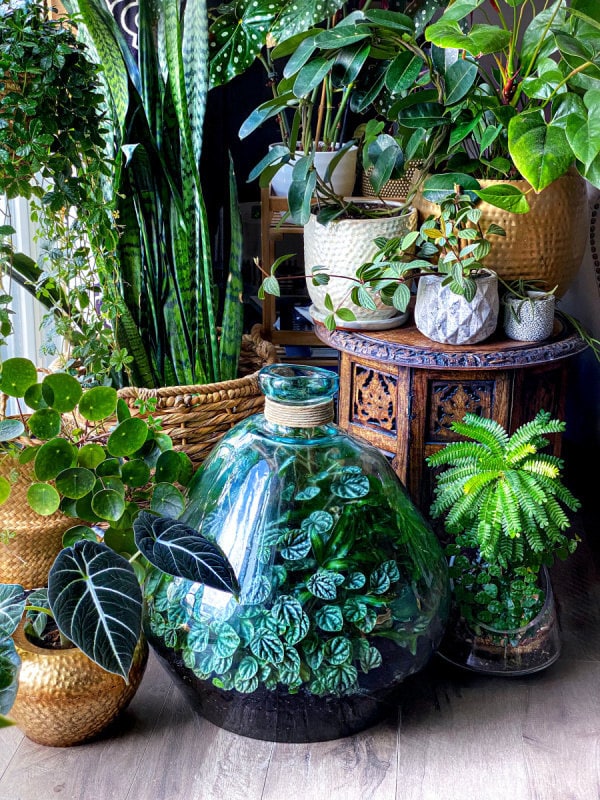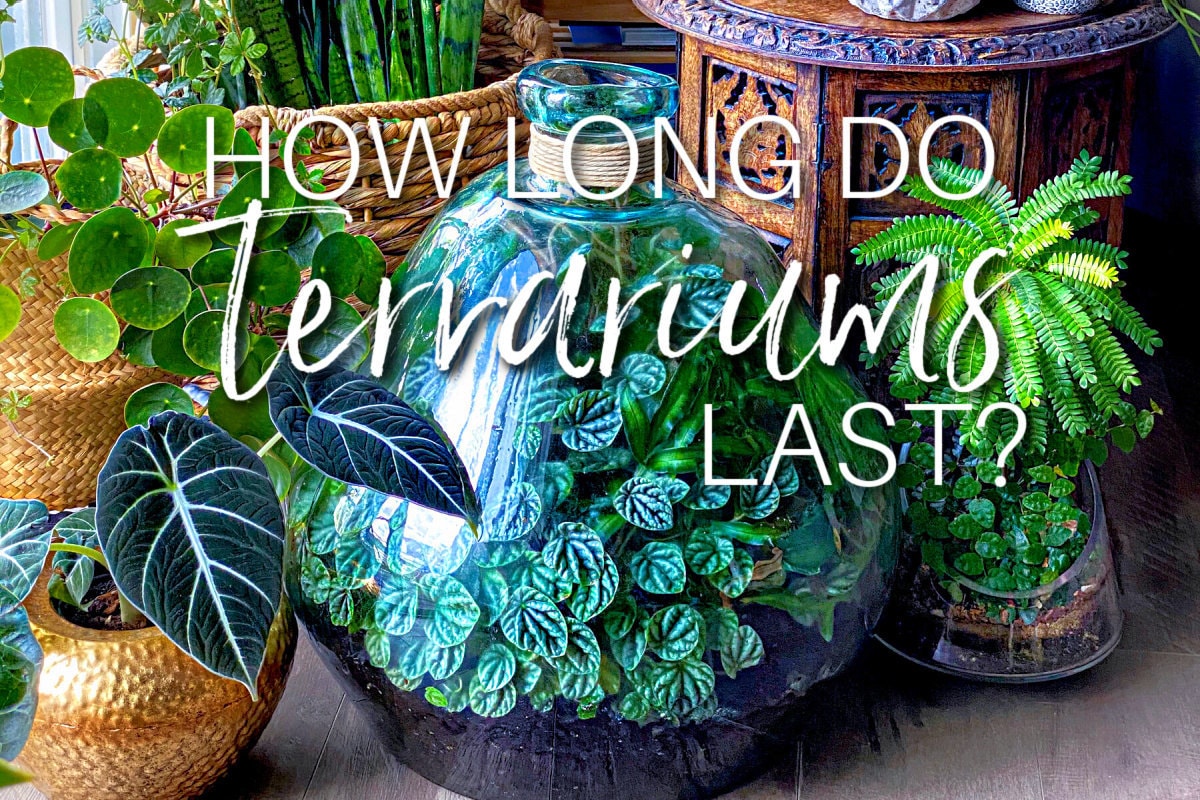By Patricia Buzo, author of the book A Family Guide to Terrariums
One of the top 5 questions I hear is "how long do terrariums last?", and its a good one! Most of us would like to enjoy our mini landscape for as long as possible. In order to answer that question another worth asking is: does a terrarium need any human intervention or can it be left sealed indefinitely?
How long can a terrarium last?
Over 60 years ago a man named David Latimer planted a 10-gallon glass carboy bottle with s single Spiderwort sprout (genus Tradescantia) using some wires to maneuver it into place. He watered, then sealed it and didn't touch it again for 12 years. After a second watering in 1972, Latimer again left it alone but this time for 48 additional years!

Above: still going strong; David Latimer with his 60 year old terrarium (credit)
As this delightful story proves, terrariums can last a lifetime. Does this indicate that having a terrarium means setting it aside and never lifting a finger? Not exactly. Even David Latimer intervened from time to time, albeit minimally so. In an interview cited on The Daily Mail he said: ‘Its 6ft from a window so gets a bit of sunlight. It grows towards the light so it gets turned round every so often so it grows evenly. Otherwise, it’s the definition of low-maintenance. I’ve never pruned it, it just seems to have grown to the limits of the bottle.’
Granted, a terrarium like Latimer's doesn't need much fuss. There is no mini landscape to be maintained, it is simply a bottle filled with wild growing plants. In fact, inspired by this story I created something similar that's lasted several years with only minimal care (see photo below).
Why I recommend a maintenance schedule
If it's been proven that terrariums can survive on their own then why lift a finger? Simply put, because it will tend to look nicer. It also provides the plants with the best chance at survival long term. Giving your plants a periodic trim will keep them bushier and discourage leggy (read: weedy) growth. Removing spent leaves by hand verses allowing them to rot away within the jar will discourage mold and muck. Cleaning the glass on occasion lets more light in and allows you to enjoy peering inside to clearly see the contents. Doing these things doesn't equal an overwhelming investment of your time taken away from your already busy schedule. Just be proactive, give your terrarium a quick look over every few weeks and if it needs a little TLC give it some love.

Above: my 5 year old terrarium filled with Peperomia Ripple gets only minimal maintenance a few times per year
Why do terrariums last so long?
We've established that terrariums can last a long time, especially with a little intervention here and there. But what makes them so long-lived? When you place plants inside a glass vessel and seal it you are creating a mini ecosystem complete with its own water cycle. When light enters and hits the leaf surface a biological process is triggered in which the cells on the leaves soak up light rays almost like a solar panel. This allows the plant to convert the light into energy and in turn it is able to suck up water from the roots. Tiny holes on the leaves, called stomata, release some of this water in the form of vapor essentially filling the air with a humid mist. This process is called transpiration. Within a closed terrarium that means it remains very humid inside, so much so that some of that water vap0r collects on the sides of the glass and eventually trickles down into the soil keeping it evenly moist almost indefinitely. Because the soil stays saturated the water cycle process repeats itself over and over, thereby possibly never needing another watering. I will insert a caveat here that when the seal is broken by opening up the terrarium this process is disturbed. The longer the lid is off the more water is lost through evaporation. Consider too that each terrarium vessel is different and some may not have a tight seal and will therefore also lose water through evaporation, albeit slowly. In these cases it is recommended to add some of that water back into the closed system.

Above: the water cycle process of a plant is powered primarily by the sun
The process described above is primarily powered by the sun because plants need light in order to produce the energy necessary to cycle water (there are other processes at work as well, but for the sake of simplicity in this article we won't go into them). Note that a plant doesn't necessarily need direct sun rays in order to function, and in the case of the majority of plants used in terrariums only indirect light is required. Plants are so good at utilizing light for energy, their leaf cells were literally created for the purpose. That is why you may notice that some plants seem to follow the light by leaning toward it, and that is why Latimer rotated his terrarium every so often.
Some plants are not like the others
A few plants don't quite follow the rules that all others abide by and I thought it important to mention these because many terrariums, including the ones I make and sell for a living, house them. Primitive plants, like mosses, liverworts, and many epiphytes (which include some ferns) do things slightly differently. These plants often don't have any roots at all and derive the moisture they need by absorbing it from humidity in the air. If the air is dry they go dormant and may eventually die though most are pretty hardy. These plants, due to their need for a high water to air ratio, make excellent terrarium inhabitants. They also benefit from a bit more intervention in terms of adding water to the system on a more regular basis. I don't mean to say they are aquatic and need to be flooded, but they may not tolerate as much fluctuation in humidity levels. And unless your terrarium is hermetically sealed (and most are not) water will be lost over time through evaporation.

Above: Terrariums made with moss and/or depicting miniature landscape scenes will need more maintenance to keep the scene in tact and looking its best
Enjoy your terrarium for years to come
In conclusion, terrariums can last many years - and who knows, may even outlive you - thanks to the creation of its own tiny ecosystem complete with a self-sustaining water cycle. But do yourself and your plants a favor: monitor. If needed step in every now and then by way of a trim here, some water there, and enjoy your terrarium for years to come!

